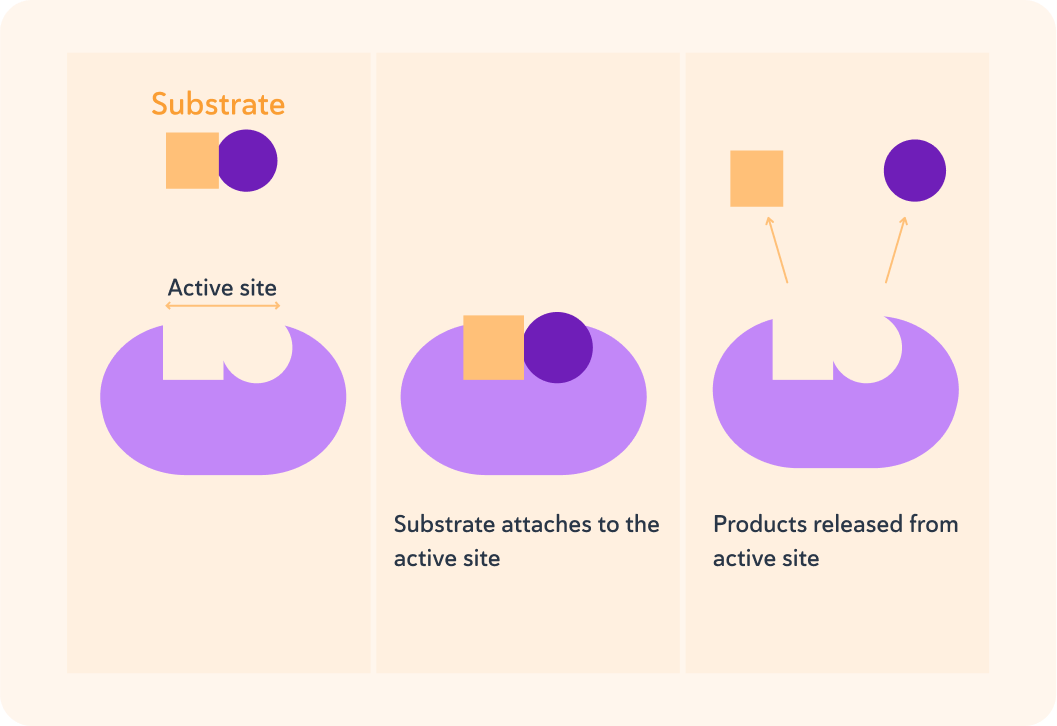YOU ARE LEARNING:
Enzymatic Action

Enzymatic Action
The mechanism of enzymatic action explains the specificity that they possess, in terms of the active site.
What is the name of a protein chain that can act as a biological catalyst?

An enzyme is a made from a long chain of _________ which fold into a specific shape. This shape is what allows the enzyme to perform its function.

All enzymes are specific in their action. This means they only catalyse one reaction. Salivary amylase is an enzyme found in the mouth. Which of these reactions do you think it catalyses?

When the amino acid chain folds, it always makes the same shape. Specifically, it creates a specially shaped part of the enzyme called the active site. What do you think this active site does in the case of salivary amylase?

The shape of the active site is a 3D mirror image of the shape of the chemicals involved in the reaction. The active site of salivary amylase, for example, is a 3D mirror of one section of the starch molecule. It's a bit like a lock and a key. The shapes have to fit!
This shows how the substrate molecule (starch) fits into the active site on the enzyme.
The product (maltose) is then released.

What has happened to the enzyme in this reaction?
A) It has changed shape. B) It has remained unchanged. C) It has been used up.


Because the enzyme is unchanged by the reaction this means it...
A) can be reused to convert more substrate into products. B) can be recycled to make a new enzyme. C) has completed its function and is of no further use.


This model ** of how an enzyme works is known as...
the Lock and Key Theory.

In this model, which is the lock, and which is the key?
A) The enzyme is the lock, because the substrate fits into it. B) The enzyme is the key, because it is unchanged by the reaction.


The idea is that the key (the enzyme) fits into the lock (the substrate) and causes a change by undoing the lock (reaction). The key is unchanged and a can be reused.
Like all models it is a simplification of the real situation to help understand what is happening.

In the example of starch, the amylase and the starch join together to form an enzyme-substrate complex. Once the reaction is complete, the complex is broken up, leaving which two chemicals?

Enzymes can be damaged by extreme conditions, though. What would happen to the reaction if the shape of the active site was significantly changed by extreme heat, for example?

Change in the shape of the active site can be caused by heat, pH changes, or the presence of other chemicals (like poisons). We call changes like that to the active site of enzymes for denaturing.
High temperatures, and incorrect pH conditions, change the way the enzyme's active site is folded. Some of the bonds are broken and the forces are altered, twisting the enzyme into the wrong shape. Do you think a denatured enzyme can be "fixed" by cooling down or putting it in a different pH environment?

In the example of starch, the enzyme breaks up the substrate to form smaller, less complex products (maltose). Is it possible to use an enzyme to take less complex substrates and produce larger, more complex products?

It's not always the case that enzymes just break things down. Some enzymes create larger, more complex products. For example, chlorophyll in plants can take water and carbon dioxide to make glucose.
